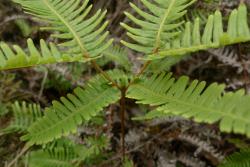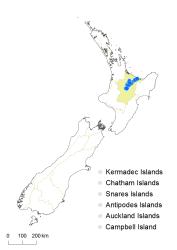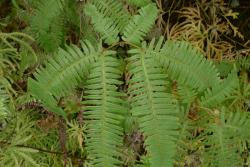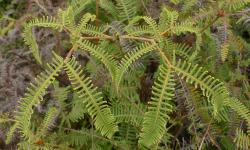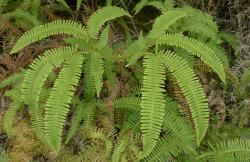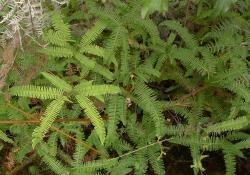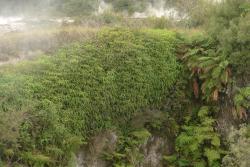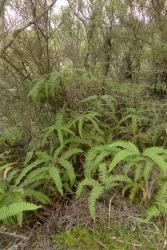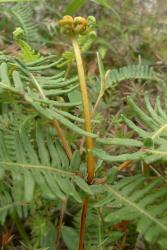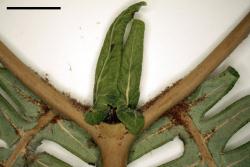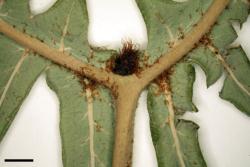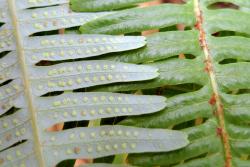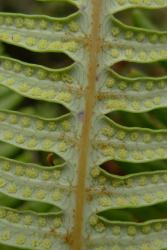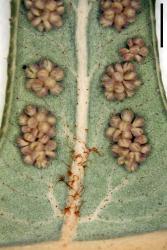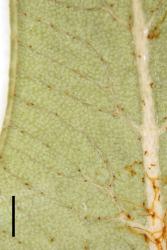- ≡ Polypodium lineare Burm.f., Fl. Ind. (N.L. Burman) 235, t. 67, f. 2 (1768)
- ≡ Gleichenia linearis (Burm.f.) C.B.Clarke, Trans. Linn. Soc. London, Bot. Series 2, 1: 428 (1880)
- ≡ Mertensia linearis (Burm.f.) Fritsch, Bull. Herb. Boissier Séries 2, 1: 1092 (1901)
- = Polypodium dichotomum Thunb. in Murray, Syst. Veg., ed. 14 (J. A. Murray) 938 (1784)
- ≡ Mertensia dichotoma (Thunb.) Willd., Kongl. Vetensk. Acad. Nya Handl. 25: 167 (1804)
- ≡ Dicranopteris dichotoma (Thunb.) Bernh., Neues J. Bot. 1(2): 38 (1805)
- ≡ Gleichenia hermannii R.Br., Prodr. Fl. Nov. Holland. 161 (1810) nom. illeg., nom. superfl. – as G. hermanni
- ≡ Mertensia hermannii (R.Br.) Poir., Encycl. Suppl. 3, 670 (1814) nom. illeg.
- ≡ Gleichenia dichotoma (Thunb.) Hook., Sp. Fil. 1, 12 (1844)
- ≡ Dicranopteris hermannii (R.Br.) Nakai, Bull. Natl. Sci. Mus. 29: 60 (1950) nom. illeg.
Rhizomes long-creeping, 1.5–3.5 mm diameter; rhizome hairs red-brown, often clustered only around apices and stipe bases or occasionally densely clothing rhizome. Fronds 140–1220 mm long. Stipes 55–960 mm long, glabrous. Laminae 90–660 mm long, 110–380 mm wide, adaxially green, abaxially usually glaucous (rarely ±green), herbaceous, hairy. Rachis bud sometimes extending once (rarely twice), hairy; rachis bud hairs red-brown, 1.2–2.5 mm long; pseudostipulate with each flanking branch bearing an accessory leaflet. Pinnae 100–350 mm long, 45–320 mm wide; with 1 (occasionally 2, with penultimate fork then pseudostipulate like the rachis bud, rarely 0) pseudodichotomous fork (excluding growth from pinna buds); pinna buds not extending or rarely extending once. Proximal-most (primary) costae 10–60 mm long, to 105 mm long in pinnae with 2 pseudodichotomous forks, lacking costal segments (excluding pseudostipules). Ultimate leaflets narrowly ovate, rarely narrowly elliptic, 90–300 mm long, 22–75 mm wide, usually angustate, rarely caudate; with 25–54 pairs of ultimate segments. Abaxial surface of α costae with red-brown branched hairs proximally, otherwise glabrous. Ultimate segments narrowly oblong, 11–42 mm long, 2–4.5 mm wide, arising at 80–85° from α costae, entire, emarginate; abaxial surface with red-brown branched hairs usually restricted to proximal part of midvein, otherwise glabrous; red-brown glands present on veins, 15–40 µm long. Sori 6–20 either side of midvein, with 7–12 sporangia each. Spores 25–27 µm long, c. 27–35 µm wide (2 samples).
Dicranopteris linearis is the only species of Dicranopteris in New Zealand. Species of Sticherus are superficially similar but are distinguished by the presence of costal segments on the β costae; Dicranopteris has none.
North Island: Volcanic Plateau.
Altitudinal range: 20–500 m.
Dicranopteris linearis is confined in New Zealand to geothermal areas, largely between Lake Taupō and the Rotorua lakes, but with a few populations also between Kawerau and Whakatāne. It extends from about 20 m above sea level near Whakatāne to near 500 m between Rotorua and Taupō. It has not been recorded from the Kermadec Islands.
Also tropical Africa, tropical Asia, New Guinea, Australia (Western Australia, Northern Territory, Queensland, New South Wales), Solomon Islands, Vanuatu, New Caledonia, Fiji, Samoa, Tonga, Cook Islands, French Polynesia, Pitcairn Island, Hawaiian Islands.
Dicranopteris linearis is confined in New Zealand to geothermal areas, often around active vents. It often occurs amongst Kunzea scrub, with Nephrolepis flexuosa, Christella dentata, and/or Gleichenia spp. It can be locally common.
Numerous varieties of Dicranopteris linearis have been recognised elsewhere; 13 in Malesia (Holttum 1959), three in Australia (Chinnock & Bell 1998).
The minute glands noted by Chinnock & Bell (1998) on the abaxial surface of the laminae of Australian plants they called Dicranopteris linearis var. linearis also occur in New Zealand plants, as well as material from New Guinea, Solomon Islands, Vanuatu, New Caledonia, Fiji, Tonga, Cook Islands, French Polynesia, Pitcairn Island, and Hawaiian Islands.
In contrast, the Australian lectotype of Gleichenia hermannii R.Br. (= Dicranopteris linearis) has very few red-brown glands on the abaxial surface of the laminae. Furthermore, the protologue of Brown (1810) states "…pinnis linearibus integerrimis obtusis,…". The apices of the ultimate segments of the lectotype are a mixture of obtuse and emarginate, whereas New Zealand material is much more regularly emarginate.
WELT P005357 (Rotomahana, E. Craig s.n.) is unusual in that hairs are abundant over the abaxial surface of the lamina and the minute glands are absent or obscured. It thus resembles other taxa, such as D. caudata (Copel.) H.St.John from Fiji.
Satisfactory measurements of spore size could not be obtained from New Zealand material in AK, CHR, or WELT; normal spore development may be uncommon in New Zealand. However, the few spores observed are considerably smaller than those of Gleichenia, consistent with the findings of Large & Braggins (1991).
Bartholomew et al. (1997) pointed out that Carl Thunberg’s names in Johan Murray’s Systema vegetabilium of 1784 should be attributed to Thunberg. The correct author citation for Polypodium dichotomum is therefore "Thunb." and not "Thunb. ex Murray".



